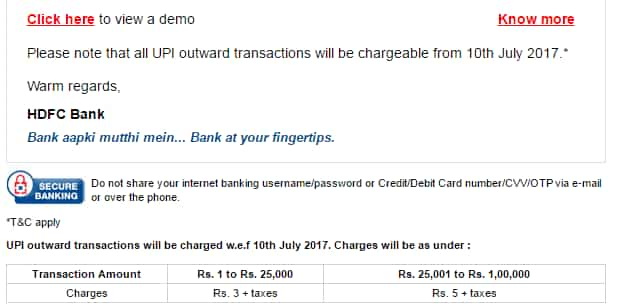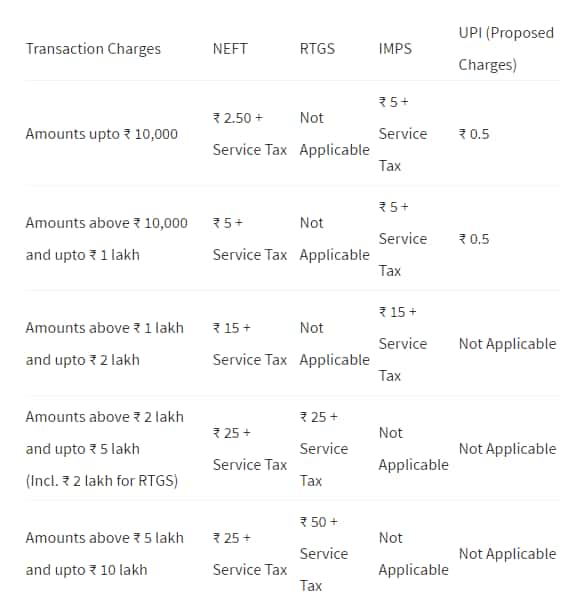Transaction charges: Which is the cheapest mode of money transfer between UPI, IMPS and NEFT?
UPI distinguished itself from other digital payment mode because of its no charges from banks, one-touch.

After many months of allowing customers transfer money for free via Unified Payment Interface (UPI), banks like HDFC Bank have now slowly announcing charges for the same.
On June 06, 2017, HDFC Bank sent an email to its customers stating that UPI outward transactions will be chargeable from July 10, 2017.

With more banks to follow the move, it is pertinent to find out which is the cheapest mode of transferring money, UPI, NEFT or IMPS?
A customer will now pay Rs 3 plus services taxes on UPI transaction between Rs 1 – Rs 25,000. While for transaction between Rs 25,001 – Rs 1,000,000 on UPI, the customer will be charged with Rs 5 plus service taxes.
UPI, since its launch in April 2015, has been an attractive mode of digital payment due to no transaction charges from banks end. More than 50 banks are offering this mode.
Pavel Naiya an analysts at Counterpoint Technology Market Research recently said, “We believe, UPI will revolutionise usage of digital payment by covering all limitations with its cross-platform functionality. Initial usage will be peer to peer money transfer. With integration of government services, bill payment gateway and merchant payment gateway etc. UPI transactions will penetrate in rural areas and likely become the main mode of digital payments in India.”
UPI is a one-touch transaction mechanism which allows customers to transfer instant money without any bank details. Unlike IMPS, RTGS and NEFT where bank account number, IFSC code is an important part for making a transaction, UPI is just made by using a virtual payment address.
Just like IMPS, UPI is also available 24X7 for customers.
Transaction charges:
UPI till now has been the cheapest mode transaction compared to IMPS and NEFT.
Transaction charges on IMPS, NEFT vary from bank to bank.

Recently, State Bank of India (SBI) announced that anyone transferring up to Rs 1 lakh on IMPS will be charged with Rs 5 per transaction plus service tax. Between Rs 1 lakh – Rs 2 lakh and Rs 2 lakh – Rs 5 lakh, service charges are at Rs 15 and Rs 25 each plus service tax.
Most banks too have similar charges like SBI on IMPS.
On NEFT, transaction up to Rs 10,000 are charged Rs 2.50 plus service tax, above Rs 10,000 till Rs Rs 1 lakh customers are charged with Rs 5 plus service tax.
Between Rs 1 lakh – Rs 2 lakh and Rs 2 lakh – Rs 5 lakh transaction – a person is charged Rs 15 and Rs 25 each plus service tax. Over Rs 5 lakh till Rs 10 lakh, customers will have to pay Rs 25 plus service tax.
This was not the case for UPI till now. On every transaction till Rs 1 lakh, institutions have charging just 50 paise.
Transactions via UPI have been growing but are still a shade on NEFT and IMPS.
Data compiled by RBI show that transactions on UPI increased in volume terms to 9.20 million in May 2017 from 6.9 million in April 2017 and 6.2 million in March 2017. Transaction on UPI which stood at 0.3 million volume in November 2016 reached to 2 million by end of December 2016.
In volume terms, UPI stood at Rs 2,770 crore in May 2017, higher from Rs 2,200 crore in April 2017 and Rs 2,390 crore in March 2017. During November 2016, UPI was just at Rs 90 crore but crossed to Rs 700 crore in December 2016 and to a whopping Rs 1,660 crore in January.
At the same time, IMPS has seen a marginal increase in May 2017 where transactions were at 66.70 million volume totaling to Rs 58,560 crore compared to 65.1 million volume at Rs 56,210 crore in April 2017 and 67.4 million volume at Rs 56,470 crore in March 2017.
Transaction on NEFT has seen moderation after March 2017. NEFT stood at 155.80 million volume totaling to Rs 12.41 lakh crore as against 143.2 million volume at Rs 12.15 lakh crore in April 2017 and 186.7 million volume at Rs 16.29 lakh crore in March 2017.
Get Latest Business News, Stock Market Updates and Videos; Check your tax outgo through Income Tax Calculator and save money through our Personal Finance coverage. Check Business Breaking News Live on Zee Business Twitter and Facebook. Subscribe on YouTube.
RECOMMENDED STORIES

Looking for short term investment ideas? Analysts suggest buying these 2 stocks for potential gain; check targets

Rs 3,500 Monthly SIP for 35 years vs Rs 35,000 Monthly SIP for 16 Years: Which can give you higher corpus in long term? See calculations
11:14 AM IST









 UPI payment services launched in Sri Lanka, Mauritius
UPI payment services launched in Sri Lanka, Mauritius  UPI Fraud: Tips to keep yourself safe from scammers while making UPI payments
UPI Fraud: Tips to keep yourself safe from scammers while making UPI payments UPI: CRED launches RuPay credit card-based payments; a step-by-step guide to use it
UPI: CRED launches RuPay credit card-based payments; a step-by-step guide to use it UPI: Here's how Indians travelling abroad can make UPI payments
UPI: Here's how Indians travelling abroad can make UPI payments UPI: How non-SBI cardholders can make UPI payments through Yono app
UPI: How non-SBI cardholders can make UPI payments through Yono app